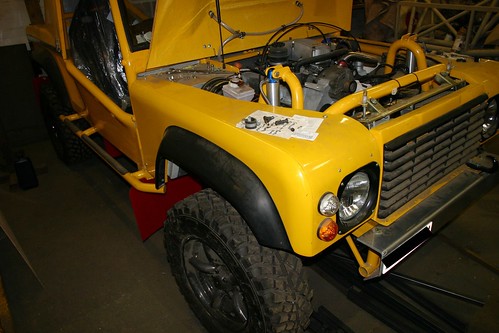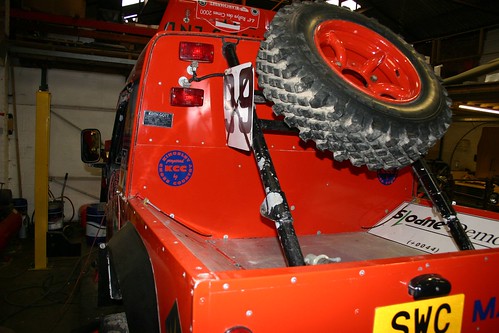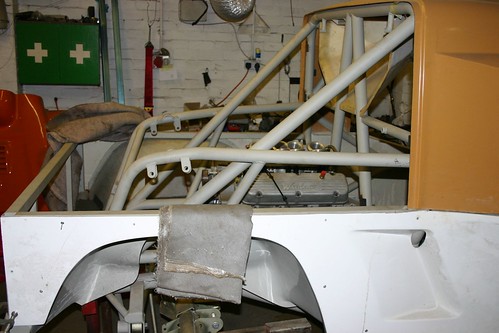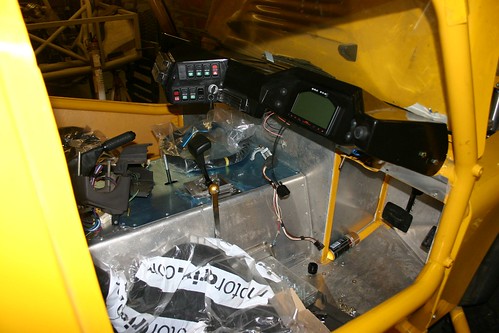October 14th, 2008
Paul said he had no problem with the prices being online, so here we go. Note that because I want it in black, the panels (excluding the internal ones) are a bit more expensive. If I was having a white one, I could knock 10% of the panel price.
- 100″ Rollcage Frame – £1300
- Pedal box (fitted) – £95
- Screen frame – £80
- Chassis prep* – £250
- Roll cage fitting – £450
- Dash (fitted) – £135
- Internal lower panels including GRP tunnel** – £290
- Upper rear bulkhead – £70
- Rear floor*** – £185
- Grill panel – £55
- Front outer wing (pair) – £165
- Front inner wing (pair) – £132
- Side panel (pair) – £264
- Roof – £209
- Truck cab rear panel – £93.50
- Upper doors**** – £264
- Tailgate – £66
- Rear inner wing (pair) – £135
- Front roof hoop trims – £49.50
- Bonnet – £148.50
- Body cappings***** – £55
* Bead blasting, bracket removal / repositioning and cleaning.
** I have no idea what a GRP tunnel is (Glass Reinforced Plastic, the Internet tells me).
*** This is for a truck cab Tomcat.
**** I’m not convinced I want these (update 17/10/08 – I was right).
***** Aluminium channels to finish rear body and corners
Not on the list are the seats and harnesses, heated front windscreen or removable steering wheel.
What else am I planning on getting? Well, in a rough order of importance, and not including parts I need for building (rivets, bolts, duct tape and cable ties*, etc (all these prices are approximate):
- Rear lights – £40
- Pacet electric radiator fan + fittings – £100 (or maybe two smaller fans at £70 each)
- X-Therm dual fan controller – £35
- A car cover – £30
- An alarm – £75
- Lockable waterproof boxes for the rear section – £?
- Seat covers** – £20
- Performance air filter – £50
- Performance exhaust system – £??
- Snorkel – £130
- Interior lighting – £20
- An ARB front diff lock (fitted) – £600
- Rear winch + bumper – £500 to £1000
- Spotlights – £90
- Extra battery + split charge system – £200
- Performance ignition leads and plugs – £80
- Voltage (one for each battery), oil pressure and oil temperature gauges – £30 each
- Simex tyres (312 900 R15) – £720
- Momo Racing pedals – £30
- Ground anchor – £90
- Waffle boards – £100
- Spare Simex tyre – £180
- 2.5 gallon air tank – £65
- Winning Lotto ticket – £1
- Road tyres on Range Rover Storm 20″ alloys – £400
- TVR Engine – £2500
*I jest (I hope)
** Unless the ones I already have fit
I’ll be adding more bits to this post as I think of them. No-one is to add this all up and tell me – I don’t want to know, cheers.
Posted in Shopping | No Comments »
October 7th, 2008
Right, I’ve sent my deposit off so Paul can order the body panels and the roll cage parts I need. It’s officially on.
Nase and I are going to take the Range Rover apart at the beginning of November. I’ve emailed Paul to ask him if he minds me discussing prices on this site.
Posted in Organising, Shopping | No Comments »
August 26th, 2008
Well, I’ve met Paul the Tomcat man and we had a long chat (a very long chat, punctuated by a lot of telephone calls. Poor Paul hardly got any work done) about the various options available and the different ways of doing things. Co-driver Nase (who is a rather freakish 6’7″ tall) also had a sit in one, and proclaimed it to have “enough room”.

This Tomcat has a 4.0l TVR engine
(Note – click on any of these pictures to go to my Flickr account where the picture is stored. On Flickr you can click on the small ‘all sizes’ button at the top of each photo to see a larger version)

The rear of a truck-style Tomcat, with spare wheel and rear floor pan.
There was plenty to look at, from a 5.0l TVR-engined rocket ship to a naked roll cage on a chassis. Paul talked us through how the cage was put together and fitted to the chassis, and how the engine is moved backwards to improve the stability.

This shows the rear of the Tomcat. Note where the chassis has been cut.
He also explained that although it could be hard work, it wasn’t overly technical. The design was simple and the amount of technology involved is up to you – if you want to turn your automatic into a flappy-paddle semi-auto, that’s possible. Upgraded engines, axles, prop shafts, diffs, brakes, suspension and pretty much everything else is available, too. If you want to use as much of your original vehicle as possible (which I do), that’s fine too.

An experimental rear-engined Tomcat.
So now it’s down to me to decide what I want to do so Paul can get a quote together for me. Prices can vary depending on what you want, and how much of it you want to be done by Tomcat for you. I’ll put my thoughts about that in the next post.

The insides are basic, to put it politely. Hopefully mine will have a steering wheel.
I took a whole bunch of pictures – you can see them in a Flickr group here.
Posted in Organising | No Comments »
August 19th, 2008
Myself and good chum (and future co-driver) Nase will be taking a trip to Lincoln to visit Tomcat HQ one week from today. Exepct lots of pictures.
Posted in Organising | 3 Comments »
August 1st, 2008
I emailed Tomcat Motorsport to ask a few questions.
1: What are the instructions that come with the kit like?
The Tomcat is not a ‘kit’ in the sense that you receive a pack of parts that all simply bolt together and you end up with a finished car, most Tomcats are built to a specific customer spec either by us or the owner. This tends to mean that all are more or less unique and we try to allow this in the way the parts are supplied. The basic build does require some fabrication ability or you would need to get us to fit the skeleton to the chassis.
The instructions for this part are provided but again as this should be undertaken by a someone with fabrication skills the instructions are fairly basic.
2: Can I keep the current Range Rover interior (ie. front seats, dash, etc)?
The only parts from inside the range rover that are retained is the steering column and pedals, non of the interior trim will fit although parts of the dash may be able to be fitted with modification although we have not tried this.
3: Do you sell brackets for mounting the radiator behind the cab?
We can provide the radiator brackets for behind the main hoop but would need to know the spec of your rad to be able to do this.
4: How secure are the doors?
As the Tomcat was designed as a competition car the doors are not necessarily designed to be totally secure, the best security is provided when building what we call a flat sided car (ie full height doors and not the climb over door bars) this uses a modified Land Rover door top on a fabricated door frame and can be made as secure as standard series Land Rover.
5: How much of the chassis will need to be cut or modified?
If retaining the standard 100″ wheelbase only the rear of the chassis needs to be cut, we remove all of the chassis from approx 100mm behind the rear springs and replace this with parts from our fitting kit, the front of the chassis is usually shortened also but this need not be, all of the unused outriggers and brackets are also removed.
6: How long does it normally take between an order being placed and being ready to collect?
Depending on what exactly is ordered usually betweeen 6 and 8 weeks are needed to produce the parts ready for collection provided that the demands of the competition calander do not interfere with production.
Posted in Organising | No Comments »
July 25th, 2008
I own a 1990 Range Rover classic known as Jeremy. Here it is:

Jeremy the Range Rover
As you can see, Jeremy isn’t your typical school-run 4×4, it’s just a big toy. It’s a 3.9 Vogue EFI with Recip Trial tyres, a 2″ lift, rear ARB locker and a Warn winch, among other things.
Off-road, Jeremy is pretty good (although he developed an allergy to water on the Billing off-road course this year), but the approach and departure angles and the overall weight cause a lot of problems. I’ve thought about bobtailing, but that wouldn’t really help with the weight issue, and is quite a job if you want to do it well.
Then I saw a Dakar kit at Billing, which is a fiberglass body and a roll cage sat on a (pretty much) unmodified Range Rover chassis. That got me hunting around on the web for bodykits, and although the Tomcat kit means I will lose the rear seats (Hell, I’ll lose the interior), I’ve decided that’s the one I want. There’s nothing really wrong with the Dakar kit, but I couldn’t make up my mind about the looks, and it’s a little more expensive, too.
During my search, I found very little useful information about building a Tomcat, which is the reason I decided to set up this site, and I’ll try and keep a detailed record of everything involved.
Here is a picture of a Tomcat – I don’t think I want the roof on the back, though.

Image from TomcatMotorsport.co.uk
Posted in Organising | 1 Comment »






